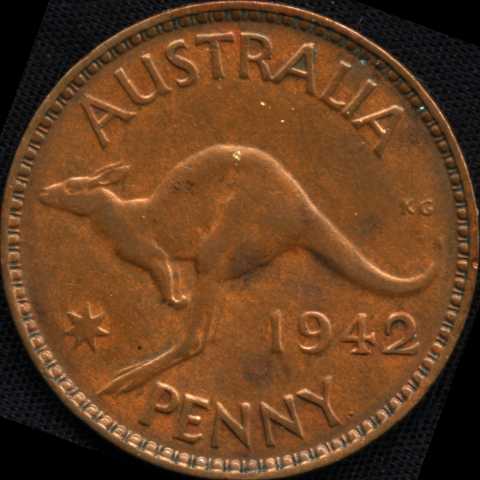
The 1942 Perth penny was struck using obverse and reverse dies made from the
1938 Melbourne master tools (obverse 3 and reverse D.)
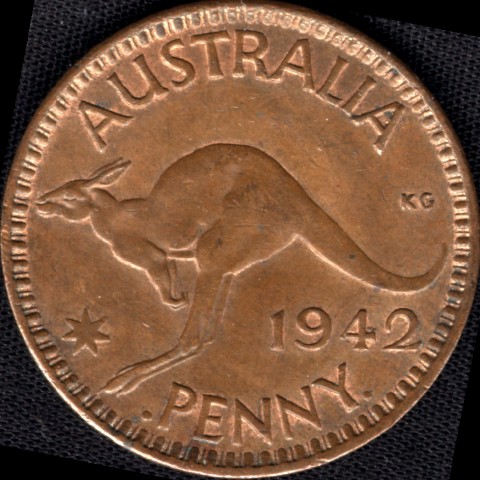
|
|
Australian pennies dated 1942 were minted in Perth and Bombay. Besides using
distinctly different obverse and reverse dies, the Perth issues were identified
by a small dot after the Y in PENNY whereas the Bombay issues had larger dots before
and after PENNY which were probably part of the design rather than mint marks
as such. Slight variations in the position of the Perth mint mark indicate the use
of multiple working dies.
The Bombay issue occurs in two varieties distinguished by the presence or absence
of an I mint mark on the obverse below the effigy of George VI.
Contents
Mintage figures
Reverse designs
Perth mint mark variations
Obverse varieties
A minor mystery
|
Designation |
|
|
|
Mint |
|
|
|
Mintage |
12,244,800 |
9,000,007 |
 |
Perth issue, P42P.3D The 1942 Perth penny was struck using obverse and reverse dies made from the
1938 Melbourne master tools (obverse 3 and reverse D.) |
 |
Bombay issue, P42.4E.B |
The mint marks on the 1942 Perth pennies occur in a variety of positions. Opinions
differ as to the importance of these variations. Most people don't consider them
very interesting but someone with the far more patience, skill and equipment than
I possess could conceivably associate any given coin with a specific working die.
Paul Holland's view on the matter:
I agree that the mintmark positions show these to be from different working dies. Variations in the position of the dot mintmark seem to be a common feature until the late 1940s, suggesting that these were individually punched onto each die. Assuming this to be the case, the number of different positions would be very large with many nearly indistinguishable. Not a very collectable situation.The following examples show just three variations.
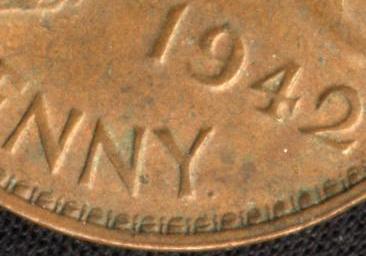 |
Mintmark dot in low position. The dot is level with the base of the Y and an imaginary
(curved) line drawn along the base of the letters would bisect the dot. Note also that the dot is to the left of the division between the rim denticles. |
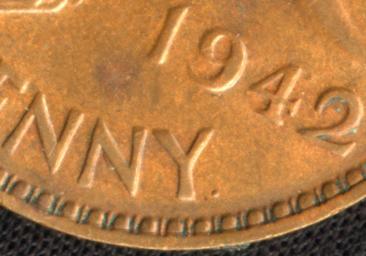 |
Mintmark dot in intermediate position. The dot would sit on top of an imaginary
line drawn along the base of the letters. Note also that the dot is slightly to the right of the division between the rim denticles below it. |
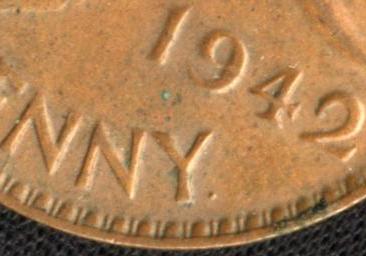 |
Mintmark dot in high position, clear of the baseline of the lettering. Note that the dot is centred between the rim denticles below it. |
 |
P42P.3D The Perth issue used the "Melbourne 1938" obverse (3). |
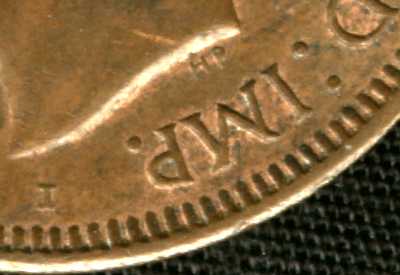 |
P42B.4E.1 Normal Bombay obverse (4) with the I mint mark under the king's head. Mint mark
occurs in several positions. Denticles are longer than those of the Perth coins. |
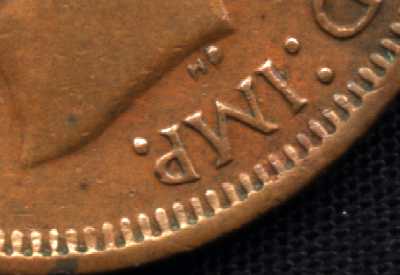 |
P42B.4E.2 Scarce variety, mint mark missing. Probably struck from a die made before an
I punch was available or from one where the I was omitted by oversight. |
A mystery
In an article "Notes on Australian Pre-decimal Coinage" (Journal of
the Australian Numismatic Society, 1996), Bill Mullett wrote:
The 1942 PennyNow while this little tale seems to explain why a few of the 1942 Bombay coins are devoid of a mint mark, it raises other questions. The dies which Bill Mullett sent from Melbourne to Bombay would surely have been the same as those sent to Perth, i.e. obverse 3 and reverse D. If that were the case then clearly those were not the dies used in Bombay. Would Melbourne really have produced significantly different dies for Bombay? If so, why? If not then where were the Bombay obverse and reverse dies made and what happened to the dies sent from Melbourne?
The combined efforts of the Melbourne and Perth mints could not satisfy the demand for Australian coins in 1942, 43 and 44. Contracts were let with US mints for the production of silver coins and with the Bombay Mint for the striking of both pennies and halfpennies. In the latter case, the coins can usually be recognised by the letter "I" being placed under George VI's portrait on the obverse of both coins.
However it is well known that some 1942 pennies struck in Bombay do not show the "I" mintmark. It must be remembered that it was wartime and the need for coins was urgent. I personally packed, addressed and wrote out the Customs Declaration for the first pairs of master dies and punches sent to Bombay. They were made at the Melbourne Mint and did not have an "I" on them for the excellent reason that Melbourne did not possess an "I" punch. It seems that, the need being urgent, they were put to use immediately on arrival, and later a new master tool was struck using an "I" in Bombay's possession or which they acquired from elsewhere.
A hint of an answer comes when we also consider the halfpennies. The Melbourne
obverse was used for 1942 and 1943 halfpennies (which incidentally confirms that
the dies actually arrived in Bombay) but the reverse die was not used. My conjecture
is that with the exception of the halfpenny obverse, the dies from Melbourne presented
the Bombay Mint something of a technical challenge. Perhaps its coining presses
could not render the high-relief designs properly so the Bombay Mint elected to
prepare new tools more suitable for its equipment.